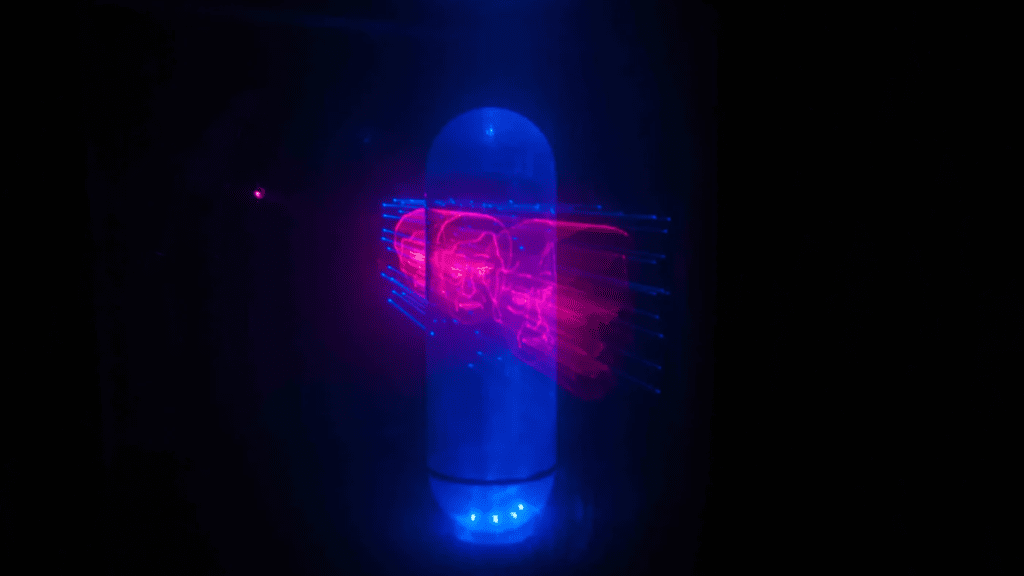Constellations Fourth Kosice Biennial (2016) Ashes are the final vestige we have of materiality. Throughout life, our bodies are constantly changing, exchanging atoms with the environment and completely renewing their matter roughly ten times during their lifespan.
Constellations features the projection of three faces reflected onto human ashes suspended in the air, symbolizing a sort of reunion or rebirth akin to a Phoenix rising from the ashes.
The piece consists of a transparent acrylic capsule within a dark cabin filled with suspended smoke, which acts as a screen displaying portraits drawn by laser beams. These portraits are of the artist, his sister Elena Fargas, and Gyula Kosice, to whom tribute is paid. Lasers, emitted from a projector equipped with internal mirrors, trace these magnified faces in the smoke.
How do we remain who we are if we are constantly changing? Where does our existence, our consciousness, reside? Is it within the physical substrate of our materiality that life is housed? Perhaps spirituality and matter converge energetically in a way that transcends our understanding. Are they separate, or merely one entity?
Constellationsdraws from similar concepts as Fargas’s earlier workSoulwarealso based on matter, life, and spirit. Allis Third Kosice Biennial (2014) Third Prize: Special Kosice Biennial Distinction oAfter hundreds of millennia, humanity has transcended its material state, becoming as fluid as plasma, a state beyond liquid and gas. Alliss*, a machine designed to retain fluidity, revisits the concept of movement using natural elements such as water and kosicean liquid, a constantly moving fluid quality**. Like liquids, other states of matter, such as plasma—the most abundant state on Earth and in the visible universe—possess an even greater capacity for fluidity and movement.
Alliss incorporates the concept of fluidity by combining different states of matter and forces. This project integrates scientific, technological, and artistic knowledge to explore new forms of collective communication. It suggests that brain activity, water, gas, light, heat, electricity, magnetism, and the human body serve as mediums for the dispersion and transformation of matter, as well as potential sources of energy and future human movement.
*Portable Madí Dictionary, Gyula Kosice, Buenos Aires, Argentina 1948. Alliss: Manufacturing of fluid retention machines. **In biology, parts of organs that are replaced by inanimate pieces. This is the function they perform.
Hydrosmos GK1 Second Kosice Biennial (2012) Special Mention for Career and ResearchHydrosmos GK1 reimagines our relationship with the environment, proposing a future where humans interact and coexist with natural forces, inhabiting and living alongside weather phenomena that constantly threaten humanity. Conceived from the idea of a Hydrospatial City, this habitat is situated in the air, not in calm air, but within a storm, a tornado.
Drawing from concepts of past visionaries like Master Kosice, beings from the future tell us about Hydrosmos GK1, not as a distant utopia, but as a real future being built right now through imagination, art, science, and technology. The city is conceived not just as a physical space but as a symbolic one where we can understand humanity’s need to transcend the earth and even its own body.
“Man is not meant to end on earth,” proclaimed Kosice in 1944. The premise is to free ourselves from the terrestrial surface, which could become barren and inhospitable, and to inhabit the air. It is pertinent to consider other viable ways to continue our existence. What would happen if we thought about the impossible?
Hydrosmos GK1 envisions a future where it might be possible to inhabit the storm, using wind forces as energy sources for support. This alternative space poeticizes the current struggle of antagonistic factors in a habitat capable of understanding both man and nature in a modus vivendi of unity and coexistence. Turning the impossible into the possible.
More information: Kosice Biennial
